ARCHIVED - Codes, Standards and Regulations Influencing Energy Demand - Energy Briefing Note
This page has been archived on the Web
Information identified as archived is provided for reference, research or recordkeeping purposes. It is not subject to the Government of Canada Web Standards and has not been altered or updated since it was archived. Please contact us to request a format other than those available.
ISSN 1917-506X
Codes, Standards and Regulations Influencing Energy Demand - Energy Briefing Note [PDF 1139 KB]
Energy Briefing Note
Codes, Standards, and Regulations Influencing Energy Demand
November 2008
Copyright/Permission to Reproduce
Table of Contents
- Foreword
- Introduction
- Building Sector
- Transportation Sector
- Industrial Sector
- Observations
- Appendix 1 - Green Building Initiatives
Foreword
The National Energy Board (NEB or the Board) is an independent federal agency that regulates several aspects of Canada's energy industry. Its purpose is to promote safety and security, environmental protection and efficient energy infrastructure and markets in the Canadian public interest[*] within the mandate set by Parliament in the regulation of pipelines, energy development and trade. The Board's main responsibilities include regulating the construction and operation of interprovincial and international oil and gas pipelines as well as international and designated interprovincial power lines. The Board regulates pipeline tolls and tariffs for pipelines under its jurisdiction. In terms of specific energy commodities, the Board regulates the exports and imports of natural gas as well as exports of oil, natural gas liquids (NGLs) and electricity. Additionally, the Board regulates oil and gas exploration, development and production in Frontier lands and offshore areas not covered by provincial or federal management agreements. The Board's advisory function requires keeping under review matters over which Parliament has jurisdiction relating to all aspects of energy supply, transmission and disposal of energy in and outside Canada.
The NEB monitors energy markets to objectively analyze energy commodities and inform Canadians about trends, events, and issues. The Board releases numerous research reports. This report is a briefing note - a brief report covering one aspect of energy commodities. Specifically, this report examines the influence of recent codes, standards, and regulations on energy demand in Canada.
If a party wishes to rely on material from this report in any regulatory proceeding before the NEB, it may submit the material, just as it may submit any public document. Under these circumstances, the submitting party in effect adopts the material and that party could be required to answer questions pertaining to the material.
Introduction
Codes, standards, and regulations impact the efficiency of energy using products entering the market. In the long-term, the deployment of high efficiency products versus inefficient products impacts the efficiency of our economy. Recently, there has been an increase in activity related to regulated energy efficiency. This briefing note provides an overview of important changes to energy performance and how it impacts the energy demand in buildings, appliances, industry, and transportation. Energy performance is generally characterised as efficiency, meaning energy fuel input compared to useful energy output. Energy performance takes the efficiency comparison one step further by taking into account energy used to provide a consistent level of service.
The terms codes, standards, and regulations are often used interchangeably; however, there are functional and legal distinctions. A standard generally refers to technical specifications or other criteria that a product or process must meet. To be credible, standards are developed through an established and transparent process, allowing input from several interested parties, and usually overseen by a recognized standards development organization such as the Canadian Standards Association (CSA). Standards can be either mandatory or voluntary. A code generally refers to several standards collectively. A code or standard could become a legal requirement in jurisdictions where it is adopted. Regulation refers to a mandatory requirement supported by legislation. The regulator could be any federal, provincial or municipal government, or appointed authority with the jurisdiction to oversee the acceptability, application, and enforcement of rules and regulations[1].
[1] Definitions as defined by Industry Canada (Office of Consumer Affairs).The term "regulator" in this briefing note refers to the authorities overseeing product energy efficiency performance. This is not part of the National Energy Board mandate.
The national standards system in Canada is a highly-integrated and collaborative process that involves government, industry working groups, non-governmental organizations, testing and research authorities, and international committees. Once a standards development organization has completed a standard, it can request the Standards Council of Canada to recognize the standard as a national standard. For standards on energy efficiency, Canada has earned a reputation as having one of the most extensive and successful programs in the world. A central partner within the national standards system is Natural Resources Canada (NRCan) and, in particular, the Office of Energy Efficiency (OEE) branch. Their analytical work provides the basis for much of the material in this briefing note.
In recent years, there has been a fundamental shift in regulatory style that is evident in energy efficiency objectives within the building, industrial, and transportation sectors. To better accommodate multiple stakeholder input within the collaborative process, regulators have moved from a purely prescriptive regulatory emphasis to a more goal-oriented, or objective-based format. The emphasis is less on details about how efficiency is achieved, and more on final results obtained. Objective-based regulation allows for more flexibility within regulations to meet or exceed minimum requirements, and allows for ongoing technology improvements. In terms of monitoring energy demand trends, it supports a shift in emphasis to a more holistic, systems-based approach to energy consumption. All of these factors are taken into account as part of ongoing energy demand analysis that the National Energy Board conducts as part of its monitoring energy markets in Canada.
Federal Energy Efficiency Agenda Overview
Currently, energy efficiency programs and policies are more likely to be tied to broader objectives of climate change and protection of the environment. At a national level, the latest updates to efficiency standards in Canada have been launched under the broader mandate of the Clean Air Regulatory Agenda[2]. These measures are grouped in the ecoAction programs as outlined in Turning the Corner: An Action Plan to Reduce Greenhouse Gases and Air Pollution[3]. Provincial energy efficiency programs are also backed by much broader climate change initiatives. It is interesting to note that many of the latest amendments for equipment standards include not only equipment, but consideration for how equipment is used. For example, residential natural gas furnace efficiency is a function of combustion efficiency, blower efficiency, and controls (including thermostat). In commercial buildings, it is widely recognized that both new and older buildings are not operating at optimal designed efficiency and programs addressing operation and maintenance are now being formulated to supplement equipment efficiency standards.
[2] Federal greenhouse gas emission and air pollution strategy information is available through Environment Canada, ecoACTION. Additional information specific to energy efficiency regulations is available in Canada's Energy Efficiency Regulations, Natural Resources Canada, Office of Energy Efficiency (2007).
[3]. Turning the Corner Plan. Environment Canada, 2007.
At present, the Canadian standards regime is characterized by a patchwork of codes as provinces, and in some cases municipalities, adapt varying degrees or elements of federal codes. In July 2008, the Council of Energy Ministers (composed of federal, provincial and territorial energy Ministers) recently endorsed an improved national energy code for buildings and publicly stated a renewed commitment to efficiency and conservation. New measures would have the potential to reduce energy demand in Canada by an amount equal to almost 25 percent of today's energy use by 2030[4]. To this end, several industry-specific national working groups are now actively bringing forth a whole suite of recommendations on individual energy-using equipment, as well as long-term visionary goals for efficiency in various sectors. The time lag between proposed changes to regulations and when regulations actually become law can extend to several years. The schedule allows for consultation, regulation development, posting draft versions, feedback, and final approval[5].
[4] Energy Ministers' Conference: Collaborating on Canada's Energy Future: ecoAction News Release. Government of Canada, September 25, 2007.
[5] Canada's Parliamentary bulletin, The Canada Gazette, draft regulations (Part I) are posted for 75 days for comments, proceeded by final approval and posting (Part II).
Standards, codes, and regulations are presented within this briefing note, by specific sectors: buildings, appliances, transportation, and industry. Table 1 lists efficiency standards that are currently proposed for revision as part of the federal government climate change strategy[6]. These are presently in various stages of consultation.
[6] The Government of Canada's plan to regulate greenhouse gas emissions and air pollutants. Environment Canada, 2008.
Table 1: Federal Energy Efficiency Regulations: High Level Overview
| Sector | Existing Guideline | New or Pending Update |
|---|---|---|
| Buildings | Model National Energy Code for Houses (1997) Model National Energy Code for Buildings (1997) |
New energy efficiency component to be phased in starting in 2010 with full energy performance standards to be released in 2012. |
| Appliances | Energy Efficiency Act (1995 with subsequent amendments) | Canada Gazette June 2008. Amendment 9: air-conditioners, heat pumps, refrigerators, freezers, exit signs, lighting. Amendment 10: dehumidifiers, dishwashers, gas furnaces, traffic signals, speciality lighting. |
| Transportation - Passenger vehicle | Motor Vehicle Fuel Consumption Standards Act (1985) Memorandum of Understanding (MOU) between industry and government (2005) |
MOU replacement Revision 2010 to be announced. (Aligned with U.S.) Renewable fuel standard.(additional) |
| Industry | Individual equipment under Energy Efficiency Act (1992) | Efficiency standards primarily influenced by Turning the Corner Plan (20% reduction by 2020) |
Market Transformation
To help put the proposed changes to codes, standards, and regulations into context, Figure 1 shows Canada's energy demand by sector.
Figure 1: Secondary Energy End-Use Demand Shares (2004)
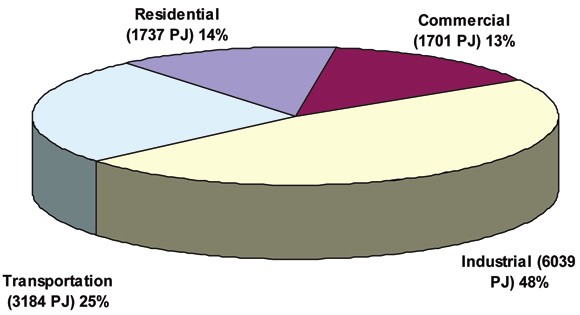
Source: NEB
Canadian energy efficiency improvements rely on a combination of mandated standards and marketing and promotion measures. Regulations are primarily designed for improving the energy performance of the worst of the sector's performers, and establish the minimum energy performance (MEP) of new goods and services coming into the market[7]. At the same time, it is expected top-level energy performers, which represent the best available technology, would also continue to improve. In this way, the average energy performance is represented by the removal of the worst from the market, and the "pull" of newly-established top performers. In addition, awareness programs, particularly labelling programs, help inform consumer choice. Premium products are promoted through additional labelling or branding programs such as ENERGY STAR. Using the example of refrigerators, all three measures contribute to the aggregate performance of new products (Figure 2).
[7] Minimum energy performance (MEP) is now an internationally recognized term used for benchmarking product energy efficiency based on consistent levels of service.
Figure 2: Multi-level Approach to Market Transformation
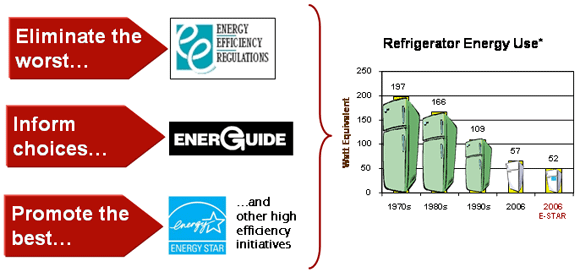
Source: Office of Energy Efficiency
The curve representing the whole spectrum of performance is shifting toward higher efficiency (Figure 3). The pace of this improvement in energy performance, which takes place over years, depends on the extent of regulation and the complementary tools used to encourage the development and adoption of more efficient technologies. These tools include awareness and information campaigns, and research and development for improving technology.
Figure 3: Advancing Energy Efficiency
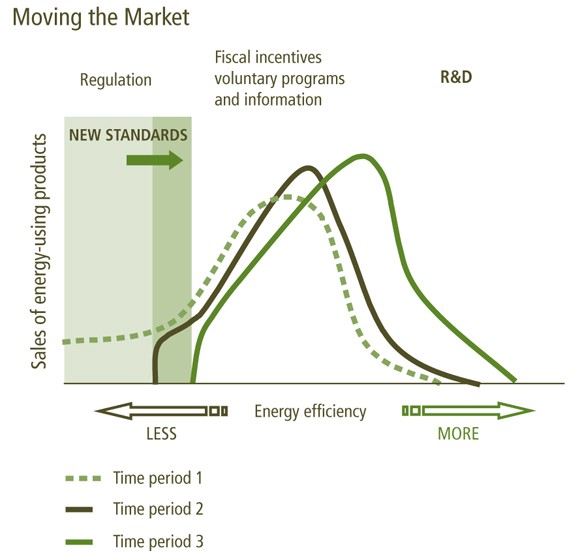
Source: Office of Energy Efficiency
With the proposed additions and amendments to the Energy Efficiency Act, regulations will be in place for equipment that accounts for 80 percent of the energy used in the residential, commercial, and industrial sectors[8]. Successful transformation of the market depends not only on the improving efficiency of incoming new devices, but also the retirement of old equipment from the market. In the example of refrigerators, stock turnover can be encouraged by public information programs and offering incentives such as an "old fridge round-up" program.
[8] Under the Energy Efficiency Act, Canada has implemented minimum energy performance standards for a number of products since the Act's approval in 1992. The amendments introduced in Bill (S-4) will modernize the Act by increasing its scope and effectiveness. See Public Statement of Environmental Effects: Bill S-4 - An Act to Amend the Energy Efficiency Act.
Building Sector
Buildings represent 30 percent of the energy consumption in Canada[9]. There are wide variances in energy efficiency within the building sector. According to NRCan data, residential energy intensity measured as energy per unit of floor space has been decreasing at one percent annually from 1990 to 2005. In this timeframe, commercial energy intensity has increased at about 0.6 percent a year. Energy performance for buildings is seen as one of the most accessible opportunities for energy savings and greenhouse gas (GHG) emissions reductions. A 2006 report for the Canadian Gas Association identified residential use as the largest energy saving opportunity and the combined residential and commercial building opportunity accounted for 75 percent of the total opportunity for energy savings[10]. There is widespread public interest in improving the energy efficiency of buildings. A survey for the Consumers Council of Canada found 86 percent of new home buyers consider energy efficiency in home buying as "important" or "very important", and nine out of ten new home buyers would give energy efficiency a higher priority in purchasing their next home[11].
[9] Energy Use Data Handbook. Natural Resources Canada, 2006. Appliances and equipment included in sector share.
[10] Demand Side Management Potential in Canada: Energy Efficiency Study. Marbek Resource Consultants, MK Jaccard and Associates, 2006, Prepared for the Canadian Gas Association. (Note: study did not include transportation sector).
[11] Energy Efficiency in Building Codes. Consumers Council of Canada, 2007. Prepared for Industry Canada.
The national reference for building standards is the National Building Code of Canada (NBC). The code is prepared by the Canadian Commission on Building and Fire Codes, and is administered by the National Research Council of Canada. The NBC is a collection of documents guiding construction principles. Collectively this document guides the requirements for safety, health, accessibility, fire, and structural protection of buildings. The energy performance of buildings falls under the Model National Energy Code for Houses (MNECH), and the Model National Energy Code for Buildings (MNECB), two adjunct publications to the broader NBC. These publications provide guiding recommendations for the provinces. Building codes fall under provincial jurisdiction (and in some cases, municipal). No provinces or territories have adopted the full MNECB and MNECH in its original form, although they have adopted or adapted it to various degrees.
While the MNECB has not had a significant update since 1997, building efficiency is improving. There are some energy-related issues covered in the NBC, which is updated every three to five years. In addition, individual components of the mechanical systems in buildings are regulated separately and have been subject to ongoing efficiency improvement standards. Over the years, the energy emphasis within the NBC has included insulation, ventilation, and general building envelope issues. These recommendations guide provincial codes which are more attuned to regional issues like climatic conditions.
In June 2007, the federal government announced new funding to support updates to the national energy codes. Energy-related performance standards for building shells will be incorporated into the next publication of the construction building codes in 2010 and a comprehensive update to the MNECB and MNECH will be published in 2012. The code update will be a milestone as it is being specifically designed for energy savings and is based on a whole building system approach. It is expected that the revision will result in a 25 percent improvement in minimum residential and commercial energy building performance over the previous MNECB. The effectiveness of these changes would depend on provinces adopting this standard; however, the announcement of the update already has the endorsement of most provinces and territories and, in fact, some provinces have already taken steps towards implementation of this update.
Residential
Residential housing, including both single family dwellings and apartment buildings, accounts for approximately 17 percent of the energy consumed in Canada. The standard to which a house is constructed has a significant effect on energy consumption. Figure 4 provides an indication of energy consumption in typical homes versus homes built to industry leading standards. An R-2000 home for example, uses a third of the energy as a similar sized home constructed in the 1970s.
Figure 4: Residential Home Energy Performance Comparisons
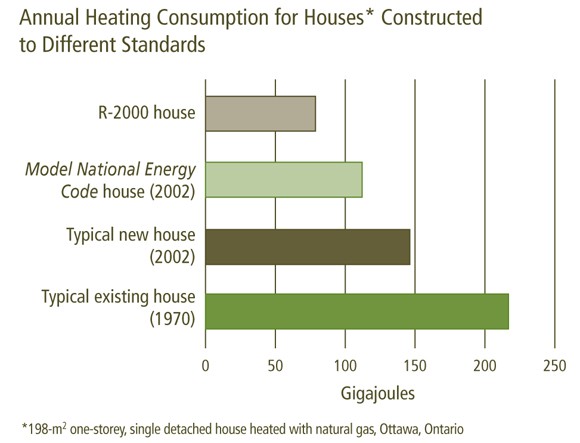
Source: Office of Energy Efficiency
A convenient way to measure the progression of housing efficiency over the years is the EnerGuide for Houses (EGH) rating system[12]. While the rating is not a code, it serves as a good general indicator of building energy performance. This rating system takes into account a number of factors and rates the home with a single number between 0 and 100. A rating of 100 would be the equivalent of a net-zero energy home[13]. Factors such as furnace rating, insulation, and air tightness are components of the EGH rating. For reference, an R-2000 home is considered equivalent to an EGH 79-80 rating. A typical new home (2002) would be EGH 70-71 and an early 1970s home would be approximately EGH 65.
[12] The EnerGuide home incentive program was wound down in 2006-2007 and subsequently replaced with the ecoEnergy program. The familiar EnerGuide rating and labeling system, however, is still very much in use.
[13] A net-zero home refers to a home that produces as much energy as it consumes (on-site energy generation), resulting in a "net-zero" energy balance on an annual basis.
The EGH works well as a reference or baseline for modeling updates to building codes. Last year, the estimated average EnerGuide rating for new houses in Canada was 73. Five provinces (Nova Scotia, New Brunswick, Quebec, Ontario, and British Columbia) have announced their intention to incorporate energy efficiency requirements within their respective building codes to meet an EGH 80 level by 2012. These provinces have begun with a stepped approach towards that level beginning in 2008-2009.
Premium performance homes (with their EGH-equivalent rating) are labeled under various program names including ENERGY STAR, R-2000, Leadership in Energy and Environmental Design (LEED®), and BuiltGreen™[14]. Exemplary green homes and building programs have recently experienced exponential growth.
[14] As of September 2006, the average EnerGuide rating for new houses in Canada has remained at 73, but this is starting to change. The average rating of houses that are actively participating in the EnerGuide for Houses labeling initiative is now at 77. In Ontario as of September 30, 2006, 8 percent of housing starts were labeled under ENERGY STAR with a minimum EGH rating of 78. In Alberta, 10 percent of new homes are labeled under BuiltGreen with EGH ratings between 78 and 80. LEED has recently moved from exclusively commercial to include residential design.
Improvements in the energy efficiency of residential housing have been limited by the fact that both regulations and green building programs have only been addressing new construction. New construction represents only about 1.5 percent of the housing stock in any year. Various retrofit standards for existing buildings are under discussion, but these are not close to enactment at this point. The average ecoEnergy home renovation results in an immediate 28 percent energy saving, a net saving much higher than the incremental gains on new home construction[15].
[15] Improving Energy Performance in Canada: Report to Parliament under the Energy Efficiency Act for the Fiscal Year 2005-2006. Natural Resources Canada, 2006.
Commercial
As with the residential sector, provinces have the latitude to interpret and set their own codes for commercial buildings. The MNECB serves as a valuable reference point for measuring shifts and trends in this sector. Determining the average performance is extremely difficult due to the wide range of buildings in this sector. Energy use per unit of floor space (energy intensity) can vary by a factor of four; consequently, the commercial sector is even more polarized than the residential sector. The rapid expansion of industry leading programs such as the LEED® accreditation program has proven very effective in influencing the market through demonstrating superior energy efficiency and an overall reduced environmental footprint. However, despite the exponential growth in the demand for premium green buildings, they remain a minor player in the market[16].
[16] Green Building in North America: Opportunities and Challenges. Secretariat of Commission for Environmental Cooperation (CEC), 2008. Green buildings are estimated to comprise two percent of the new commercial building market in U.S. and Canada.
Canada is working in collaboration with the U.S. through the American Society of Heating, Refrigeration, and Air Conditioning Engineers (ASHRAE) to develop equipment standards and building codes. There is now a high degree of collaboration between NRCan, ASHRAE, and the Canadian Green Building Council (CaGBC) in an effort to harmonize building standards across North America. Most building codes used by the provinces are adapted versions of recent ASHRAE 90.1 standards. NRCan is using ASHRAE 90.1 (2001) as its reference for the MNECB. The latest version of ASHRAE 90.1 (2004) is the most stringent efficiency standard ever and ASHRAE has a working target of 30 percent improvement in building energy performance by 2010. The latest upgrade is in line with the ASHRAE vision of net-zero carbon by 2030[17]. British Columbia recently announced that they will be adopting the ASHRAE 90.1 (2004) code[18].
[17] In 2005, the American Institute of Architects (AIA) issued the 2030 Challenge, which sets forth a target and schedule to be achieved by carbon-neutral buildings by 2030. The Royal Architectural Institute of Canada (RAIC), the U.S. Council of Mayors, and the International Council for Local Environmental Initiatives (ICLEI) have joined this initiative. In addition, over 650 U.S. cities have adopted the target. In 2007, the AIA, ASHRAE, Architecture 2030, the Illuminating Engineering Society of North America, and the U.S. Green Building Council, supported by the United States Department of Energy, signed a Memorandum of Understanding focusing on designing net-zero energy buildings, with a final goal of carbon-neutral buildings by 2030.
[18] Greening the BC Building Code: First Steps. Province of British Columbia, Office of Housing and Construction Standards (2008).
Energy efficiency improvements have been progressing independent of the MNECB update. A number of amendments to standards for individual components including air conditioning, boilers, and packaged heating units, are all coming into effect within the next year. A new commercial boiler standard requiring a minimum 80 percent efficiency, up from the previous 78 percent will influence space heating, which is the dominant energy load in the commercial sector. Commercial building efficiency is poised for improvement based on changes on several fronts. This includes the 2010 building code update, heating/ventilation/air conditioning (HVAC) equipment standards, and three cost-effective technologies now on the market: high-efficiency lighting, high-tech building automation and controls, and the pending expansion of ENERGY STAR electronic products[19].
[19] This expansion includes the one-watt standby limit on new electronic products.
Barriers, such as the common split-incentive between commercial developers and eventual occupants, can discourage the necessary investment at the construction stage. Builders are primarily concerned with construction costs, while occupants are concerned about annual costs. Other factors outside of the regulatory environment have been influential in advancing building design. Attracting and retaining top-notch staff is an important issue and employee productivity can be increased by a well-designed building. An energy efficient building making use of natural daylight and improved ventilation is generally a healthier, more pleasant working environment. The commercial building sector is diverse and highly competitive. Factors such as building codes, alongside issues such as consumer preferences for green buildings, are considered as part of analysis of commercial building energy consumption forecasts.
Appliances and Equipment
Recently the trend in analyzing appliance and equipment performance has shifted towards their consideration as part of whole building performance. As an example, furnace efficiency is one element within the general category of space heating. Space heating demand is equally a function of building shell (i.e., walls and windows) integrity. A growing list of individual appliances and equipment under new guidelines for energy performance illustrates the trend towards making energy efficiency a priority on consumer goods. Canada's system of monitoring, rating, labelling, and improving energy performance on appliances and equipment have helped to establish Canada's reputation as a world leader in energy efficiency programs. The familiar EnerGuide label is a clear and powerful marketing tool familiar to most Canadians. The labelling system in Canada has also gained from the expansion of the U.S.-based ENERGY STAR program into Canada[20]. ENERGY STAR-designated appliances are generally between 10 and 15 percent more energy efficient than the average. The market share of ENERGY STAR qualified appliances continues to grow (Figure 5).
[20] ENERGY STAR is administered by NRCan Office of Energy Efficiency in Canada.
Figure 5: Appliance Labelling and Awareness
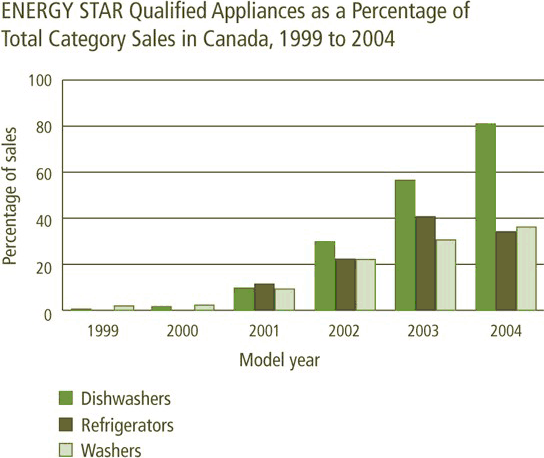
Link to EnergyGuide Label [PDF 40 KB]
Source: Office of Energy Efficiency
In October 2006, the federal government announced new energy efficiency regulations on 20 previously unregulated refrigeration, heating, and lighting products, and introduced more stringent requirements on ten previously regulated products. The anticipated effect of these changes is to save an estimated 116 PJ annually by 2030 (Table 2).
Table 2: Appliances: Annual Estimated Energy Savings (Petajoules)
| 2010 | 2015 | 2020 | 2025 | 030 | |
|---|---|---|---|---|---|
| Residential | 3.20 | 35.52 | 45.98 | 54.75 | 61.91 |
| Commercial | 4.09 | 31.01 | 42.00 | 49.68 | 54.15 |
| Total* | 7.29 | 66.53 | 87.98 | 104.43 | 116.06 |
| * Numbers may not add up due to rounding. Source: Regulations Amending the Energy Efficiency Regulations, Canada Gazette, Regulatory Impact Analysis Statement, Vol. 142, No. 13 - March 29, 2008. |
|||||
With these amendments, six general priority areas have been identified for regulations governing minimum energy performance. Three of these are near-term priorities, including gas furnaces, lighting, and standby power losses.
Gas furnaces
Space heating accounts for approximately 60 percent of Canada's residential energy demand. The proposed amendment for natural gas furnaces would see the minimum efficiency level raised from 78 percent to 90 percent in December 2009. This would add momentum to the 90 percent efficiency standard for new residential furnaces already in place in Ontario (as of 2007) and B.C. (as of September 2008). Once again, regulations in this area are supporting what is already a growing market trend. In a 2006 survey of Union Gas service areas, 90 percent of new home installations and 66 percent of retrofit installations were high-efficiency[21]. It is interesting to note that the market penetration rate for high-efficiency furnaces in 1994 was only 3.4 percent. The Canadian Gas Association considers this shift in furnace efficiency a major influence behind an emerging trend of decreasing natural gas consumption per household in Canada[22].
[21] Declining Average Customer Use of Natural Gas: Issues and Options. Canadian Gas Association, 2007.
[22]. ibid.
Lighting
Lighting consumes approximately five percent of the energy used in the residential sector and approximately nine percent in the commercial sector. The lighting efficiency change was one of the earliest and most publicized standards within the federal government slate of energy efficiency recommendations. The amendment was originally an objective-based regulation to improve lighting efficiency by 50 percent by 2012. In effect, this meant that the standard incandescent light bulb, as it exists today, would not meet the objective. Based on industry consultations, this objective has been revised to 30 percent. New incandescent technology is now close to meeting this standard, thus widening the number of technology options available for reaching the efficiency target. Specialized commercial lighting has a target of ten percent improvement by 2012. Exit signs now have a standard that effectively limits the technology to LED, allowing for a 90 percent power reduction[23].
[23] LED, or Light-emitting diode, is ultra energy efficient and poised to make a considerable impact on specialty lighting applications in the future.
Standby Power
Standby power is defined as the power consumption of equipment and appliances when the switch is in the off-position. It is estimated that standby power accounts for five to ten percent of household electric consumption and adds 616 megawatts (MW) of load to the electricity grid in Canada. This issue is basically an extension of the appliance efficiency targets; however, its role is so significant that it has been set apart for priority attention. National and international working groups are rapidly moving towards a goal of a universal one-watt standby limit[24]. Currently, some appliances such as televisions will use up to 50 watts in stand-by mode. As almost all small appliances have standby consumption, the rise in the number of appliances per house has effectively cancelled out efficiency gains on individual appliances. New regulations would ultimately reduce this by 75 percent per household. The proposed regulations for standby power are scheduled for phase-in beginning in 2008[25].
[24] Energy Efficiency Policies and Measures, Standby Power Standards 3970, International Energy Agency (IEA).
[25] Amendment to Energy Efficiency Act currently before Senate.
Transportation Sector
Transportation accounts for 25 percent of Canada's energy demand. The transportation sector includes freight and passenger movement in road, rail, marine, air, and bus transportation. Personal (passenger) transportation accounts for 55 percent of the total transportation fuel consumption. Energy use for Canadian transportation increased 33 percent between 1990 and 2005[26]. The pattern of ever-increasing energy consumption, brought on by a desire for more horsepower and larger vehicles, (which more than cancelled out efficiency gains), has made fuel economy a much debated issue, particularly in the U.S. where the majority of imported oil is going to meet transportation demand. The reference point for fuel economy standards is known as Corporate Average Fuel Economy (CAFE) in United States and Corporate Average Fuel Calculation (CAFC) in Canada. It portrays an actual combined fleet efficiency, and provides a forward looking target for efficiency. The target is mandatory in the U.S and voluntary in Canada.
[26] Energy Use Data Handbook 1990-2004. Natural Resources Canada, 2006
In December 2007, the U.S. passed the Energy Independence and Security Act calling for an average fleet efficiency of 32 miles per gallon (mpg) (7.4 l/100 km) by 2015 and 35 mpg (6.7 l/100 km) by 2020. This represents an estimated 40 percent improvement in efficiency over the current CAFE standards of 27.5 mpg (8.6 l/100 km) for cars and 22.5 mpg (10.5 l/100 km) for trucks and SUVs and is estimated to result in a saving in U.S. fuel consumption of 2.4 million barrels of oil per day equivalent by 2030[27]. The standard offers the potential to decrease the need for imported oil and to reverse the trend of previous decades of ever-increasing vehicle fuel consumption.
[27] Energy Bill Savings Estimates as Passed by the Senate. American Council for an Energy-Efficient Economy, 2007.
Canadian fuel economy standards have generally followed U.S. fuel economy standards and various agreements related to auto manufacturing exist between the countries. In November 2007, the federal government announced its intent to revise Canadian standards largely based on the U.S. standard, and incorporate elements from the existing Canadian agreement. The present Canadian fuel economy standards are based on the MOU between the government and the auto industry that is set to expire in 2010. The MOU was an addition to the established CAFC standard and was based on vehicle emissions reductions rather than energy efficiency improvements. It establishes a target of a 5.3 megatonne (Mt) CO2 emission reduction from 2005 to 2010. The intent is that industry deploys technology and government informs consumers, and the combined effort leads to measurable market transformation. To date, industry has met or exceeded the voluntary standard. The CAFC performance is the actual (lab-tested) fleet average (Figure 6). CAFC is also the reference for the standard (target).
Figure 6: Fuel Economy Standards (1990-2005)
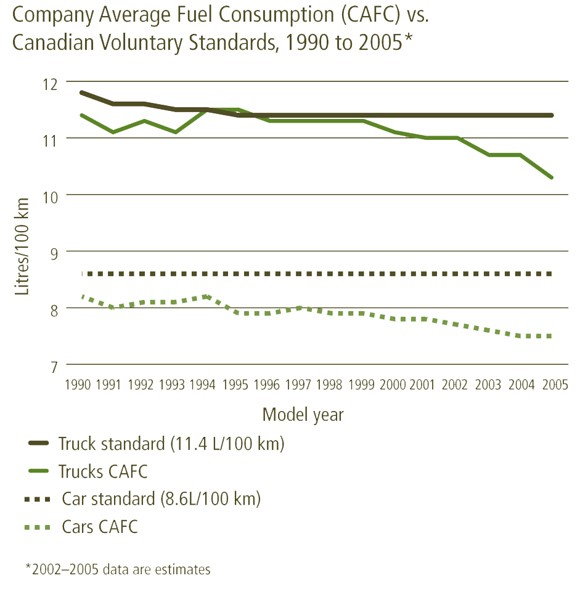
Source: Office of Energy Efficiency
Many factors determine fuel consumption, such as the profile of the vehicle fleet and the miles driven, but fuel economy is the most applicable factor related to standards. This rate of improvement is less than proposed U.S. and California standards; however, the U.S. average is based on a larger stock of large vehicles. The combined fleet average (CAFC) in Canada is lower, and thus incremental improvements have a smaller impact on consumption.
Figure 7: Illustration of GHG Emissions from Light Duty Vehicles
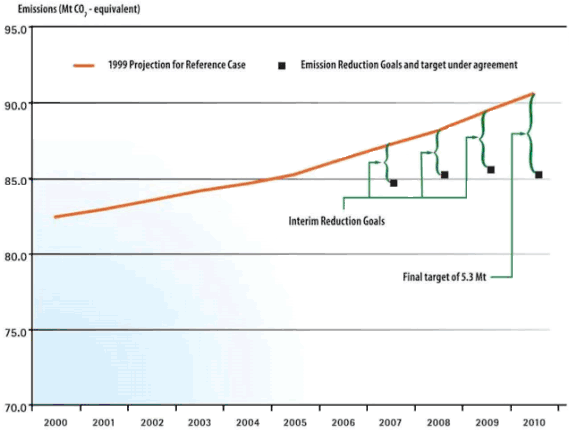
Source: Transport Canada
In addition to fuel economy standards, the federal Clean Air Regulatory Agenda in Canada proposes renewable fuel standards for vehicle gasoline as well as diesel and home heating oil. The standard presented to Parliament this year will require five percent ethanol content in gasoline by 2010 and two percent biodiesel in diesel and home heating oil blends by 2012. This will affect the amount of hydrocarbon fuels required to meet Canadian needs.
Industrial Sector
Industry consumes approximately 38 percent of the energy consumed in Canada. Proposed amendments to the Energy Efficiency Act include industrial equipment such as transformers, motors, and boilers. These proposed changes have been submitted to the Canada Gazette for review and will be open to stakeholder review in 2008 with the intent to finalize them in 2009. These efficiency amendments are the latest updates to a considerable history of efficiency improvements within industry, measures which have contributed to an average improvement in energy use per level of output (energy intensity, megajoule/$ gross output) in industry at about 1.5 percent annually between 1990 and 2004[28].
[28] Energy Use Data Handbook 1990-2004. Natural Resources Canada, 2006.
Looking ahead, the major factor influencing energy efficiency in the industrial sector is the announced federal regulations to reduce air emissions (air pollution and GHGs) from major industrial sectors. This includes fossil fuel-fired electricity generation, upstream oil and gas, downstream petroleum, base metal smelters, iron and steel, cement, forest products, and chemical production. The regulations will require 18 percent emissions intensity (emissions per unit of output) improvement by 2010 from a 2006 baseline (six percent per year). Each year thereafter, a two percent continuous intensity improvement will be required[29].
[29] Turning the Corner Plan. Environment Canada, April 2007. Implementation is expected in 2010.
One intent of the regulation is that industry would adopt internal emissions abatement strategies, most likely in the form of improved energy efficiency and fuel switching, in order to meet the target. However, within the regulatory framework, optional mechanisms such as emissions trading and clean technology investment would be acceptable alternatives and the actual end-use equipment energy efficiency may not vary significantly from the existing trend of improvement. The industrial sector clearly illustrates the challenges of imposing broad, objective-based climate change regulations into energy consumption values.
Observations
The amount of recent activity related to modifying Canadian energy codes, standards, and regulations reflects a heightened sense of urgency regarding energy and environmental priorities. At the same time, regulating efficiency depends on a whole suite of supporting tools and measures that address the established barriers to wider adoption of cost-effective efficiency improvements.
Translating amendments in codes and standards into energy demand forecasts can be difficult. There have been numerous announced changes to codes and standards in recent months; however, most of these only affect new products and infrastructure. Many end-use products have a slow turnover rate that reduces the effectiveness of changes to standards. What can be seen from the trends in efficiency in Canada is that regulations, along with other initiatives, do indeed help improve energy performance.
The NEB will continue to monitor the development and application of codes, standards, and regulations, along with all other factors influencing energy demand, in order to provide accurate inputs for its energy supply and demand market analysis. Sharing this information and analysis supports the NEB's mandate of engaging Canadians in energy issues.
Appendix 1 - Green Building Initiatives[30]
Green rating systems and initiatives have been developed to encourage the building industry to design and build in more environmentally sustainable ways. They are transforming the construction marketplace in Canada and the United States.
These voluntary tools help to focus the thinking of design and construction professionals on how to incorporate more eco-friendly practices. All consider the issues of energy use, and points are also awarded for measures such as integrated site planning, water conservation, and resource materials, pre-construction energy reduction, indoor air quality and construction waste management.
R-2000 is a federal government initiative by Natural Resources Canada to promote high energy efficiency for houses. Rather than a rating system, the program sets criteria that certified builders must meet in order to have a building certified. These standards include insulation levels, airtightness and Heating, Ventilation and Air Conditioning (HVAC) system performance. Indoor air quality and water conservation are also considered.
EnviroHome requires R-2000 certification, plus additional air quality and environmental features above R-2000 requirements. EnviroHome projects showcase new home building technology and products and promote innovative builders. The EnviroHome Initiative was established in 1994 by the Canadian Home Builders' Association (CHBA) and TD Canada Trust.
LEED (Leadership in Energy and Environmental Design) was developed in the U.S. by the U.S. Green Building Council. A Canadian adaptation, LEED NC (New Construction) Canada version 1.0, is now being used across Canada for design of commercial buildings and multi-unit residential buildings. LEED has become a major influence in green building design, with several cities and building providers requiring LEED certification for their buildings.
Canadian Green Building Council Website
LEED for Homes is an offshoot of the LEED initiative that is being piloted in the U.S. and Canada. It is directed at low-rise residential developments, with particular focus on the needs of large developers, particularly site and development issues, durability and testing protocols. The program will be launched in November 2007 in the U.S. and June 2008 in Canada.
ecoENERGY for new and existing houses is Canada's labelling program directed at improving house energy performance. Natural Resources Canada offers grants to homeowners to retrofit existing homes to higher levels of energy performance. The retrofit work must be tested by a certified energy advisor. In new houses, an advisor analyses the home blueprints prior to construction and makes recommendations for energy upgrades.
ENERGY STAR for New Homes encourages energy upgrades that will allow a home to be 30 per cent better than the current minimum provincial building codes. To date, it is being used in Ontario and Saskatchewan. A qualified home is built by licensed ENERGY STAR builders. The builder incorporates energy efficient features into the home so that it can meet the ENERGY STAR for New Homes technical specifications. The energy-efficiency features are similar to those of R-2000.
ENERGY STAR Website
BuiltGreen, developed by home builders, is a rating system now in use in British Columbia and Alberta. It applies to single-family and row homes and has three energy rating levels. Its stated goal is building durability and reduced maintenance. Points are also available for other environmental categories. The average ecoEnergy levels for these homes have been increasing annually.
Green Building Website
Green Globes, which originated in Canada, is a green management tool that includes an assessment protocol, rating system and design guide for integrating environmentally friendly design into commercial buildings, and multi-unit residential buildings.
Canadian Energy Efficiency Allilance Website
[30] Canadian Housing Observer 2007. Canada Mortgage and Housing Corporation, 2007.
- Date modified:
